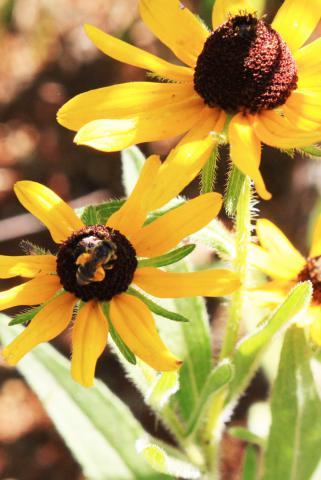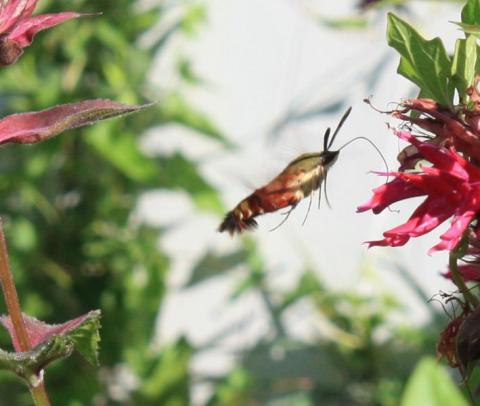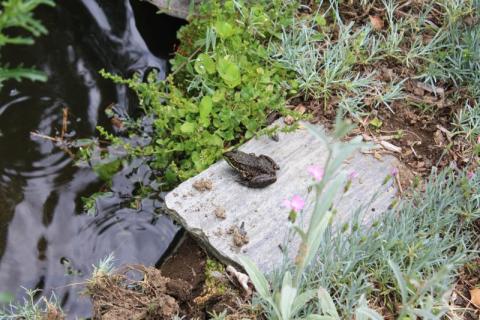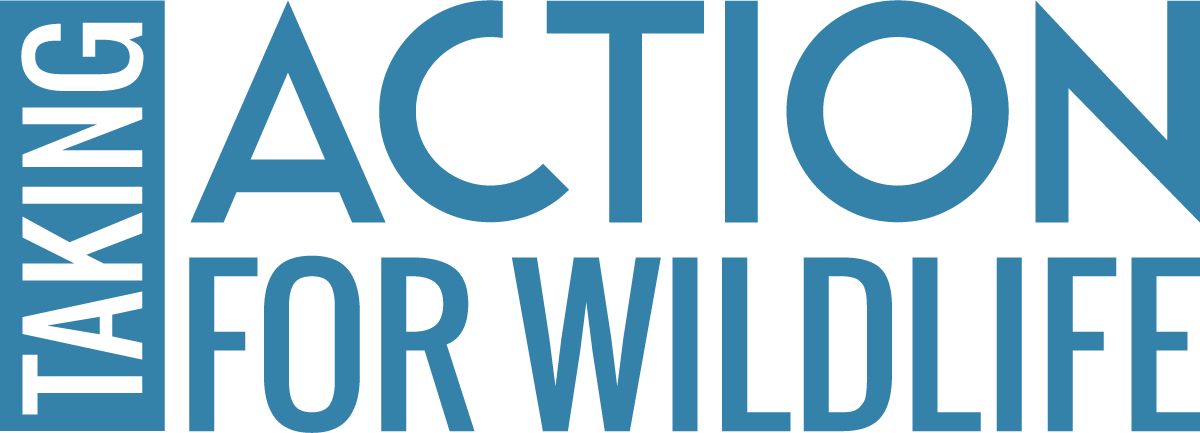Enhance your property for pollinators

A black eyed susan is visited by a bee with full pollen baskets.
Every year I try to add a few more flowering perennials to my flower gardens. I enjoy seeing the bees, butterflies and hummingbirds visiting the plants to collect their food. For me it is a win-win. I get to enjoy not only the flowers, but the insects and birds that visit them, and they get what they need to survive. The fact that there’s less lawn to mow is an added bonus.
A frequently cited statistic is that “One of every three bites of our food comes to us courtesy of pollinators” who pollinate the flowers that produce many of our fruits, vegetables and nuts. Pollinators include not only honeybees, but native bees, butterflies, moths and other insects, as well as birds and bats. As these creatures visit plants foraging for food (pollen and nectar), they move pollen around, providing a vital service, helping plants reproduce.
While beekeepers manage large colonies of honeybees to pollinate crops, we also have a variety of native bees that help pollinate our plants. It is estimated that around 200 species of native bees are found in New England. Many of our native bees nest either singly or in small groups in the ground, hollowed out plant stems, and other materials - so they don’t draw the same level of attention that honey bees do.
In recent years concerns have been raised about the health of our pollinators. Beekeepers have recognized significant losses in their bee colonies while researchers have identified declines in native bee abundance and species diversity. Lack of suitable habitat and chemical use are often cited culprits.
We can help our pollinators by considering their habitat needs as we landscape our properties. Even small areas can provide important food sources and nesting sites.
To make your property more appealing and beneficial to pollinators:
Provide pollen and nectar sources from early spring to late fall
Different pollinator species may be actively foraging anytime from March through November. Look at what you already have in your yard and evaluate which plants bloom early, in the middle, or late in the season. Identify gaps in blooming and add plants that bloom during those times.
Some early-season flowering plants include wild columbine, wild lupine and spiderwort as well as a variety of tree species including willows, apples, and cherries. Summer flowering plants include bee balm, cone-flowers, and black-eyed susans. Asters and sedums provide fall blossoms.
Plant in groups
Plant flowers in clumps rather than planting scattered individuals to make the plantings more visible to pollinators and to help them be more efficient in their gathering of pollen and nectar.

Hummingbird moth on bee balm.
Choose a variety of colors and flower shapes to attract different pollinators
Different colors and flower shapes will appeal to different pollinators. Some bee species have shorter tongues which limit the types of flowers they can access for nectar and pollen. Butterflies like to land on flowers when they are feeding, so consider adding plants that produce clusters of smaller flowers or flowers with larger petals for them. Providing diversity in flower colors and shapes will provide more feeding opportunities for different species.
Reduce your lawn area
Leave some corners and/or edges of your lawn unmown (mowing them once at the end of the season). Many of our native wildflowers such as golden rod, phlox, milkweed, clover and asters will grow in these areas if they are given the chance. These undisturbed areas will also provide bee nesting opportunities.
Incorporate different canopy layers in your landscaping
Grouping trees, shrubs, and annual and perennial plants together mimics the way plants grow together in natural systems. These groupings provide a variety of niches for insects and other animals to find food, nesting sites and shelter.

Enhancing water features can benefit pollinators and many other wildlife species.
Provide water sources
If you already have a birdbath, consider adding a few flat stones to create spots for butterflies and bees to land and safely access water.
You don’t need a lot of space to provide good habitat for pollinators. You can create an attractive landscape and also help our pollinators survive and thrive.
Researchers at UNH have been studying pollinators, identifying flower preferences, and conducting research trials to evaluate the best techniques for establishing wildflower meadows. For more information about how to successfully establish wildflower meadows and pollinator plantings, please visit the UNH Cooperative Extension web page: http://extension.unh.edu/Sustainable-Landscapes-and-Turf/Wildflower-Meadows
By Wendy Scribner, UNH Cooperative Extension
Spring 2019 Taking Action for Wildlife Newsletter
Wendy Scribner is a Natural Resources Field Specialist with UNH Cooperative Extension in Carroll County. For more information please call (603) 447-3834 or email wendy.scribner@unh.edu


